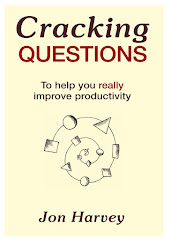The government says it has rejected advice from management consultants to cut the NHS workforce in England by 10% over the next five years... Sir Gerry Robinson, the businessman who presented a BBC series about the NHS, said he saw an "enormous amount of waste" and jobs should go. He added he was "infuriated" by yet another report, which cost a lot of money and "tells you the obvious".
Many years ago, I read a book by Edgar Schein (Process Consultation Volume 2: Lessons for managers and consultants - which is still available) and it changed my approach to consultancy. In it he describes three models of consultancy: The purchase of information or expertise, the doctor-patient model and process consultation.
I am increasingly worried that clients purchase either of the first two models when in fact they would find far greater value for money from procuring the third. As a consequence far too much of our money (as taxpayers or customers) is wasted on generating fat consultants' reports. This McKinsey report is yet another (high profile) example.
Allow me to explain.
Schein defines the first model as when "the client has made up his mind on what the problem is, what kind of help is needed and to whom to go to for this help". He cites "extreme" examples as when a lawyer is hired to assess some legal implications or hiring a systems analyst to write a computer programme. He also includes "less extreme" examples such as researching how a range of consumers feel about a service. Schein argues that psychologically the message to the consultants is "please take this problem off my shoulders and bring me back a solution". And if the solution does not work then "consultant can be easily blamed".
For Schein, this model only works if:
- The client has correctly diagnosed the problem
- The client has correctly identified the consultant's capabilities to provide the expertise
- The client has correctly communicated the problem and nature of the expertise or information that is to be purchased
- The client has thought through and accepted the potential consquences of obtaining the information or the service
As Schein points out, the "irony of this model is that the expertise is attributed to the consultant , but in fact a tremendous load falls on the client to do things correctly for the problem to be solved".
In other words when the problem is so complex, or so contentious, or too difficult to diagnose such that these success factors cannot be fulfilled, then the client will often resort to the second and sometimes the third model. (Although they often do not resulting in a waste of money.)
The 'doctor-patient' model is a variant on the model above and "gives the consultant the additional power to make a diagnosis and recommend what kind of information and expertise will solve the problem". The consultant is called in to "find out what is wrong and recommend how to fix it". This model is also fraught with elephant traps not least of which is handing over diagnosis and solution to the external consultant. This fosters dependency and allows the client to relax as someone else has taken over their problem.
As with the previous model, a number of conditions have to be present for this model to work effectively:
- The diagnostic process itself will be seen as helpful. (In other words the client has to be comfortable will allowing the consultant to 'stir the pond' and ask some very difficult questions.)
- The client has correctly interpreted the organisation's symptoms and has located the sick area. (The client may point the consultant to the wrong place and the consultant will naturally collude in an effort to be helpful and keep getting paid.)
- The person or group defined as 'sick' will reveal the pertinent information necessary to make a valid diagnosis; that is they will neither hide data nor exaggerate symptoms. (This is where this model is often stretched to far since when we go to see a doctor we are inclined to tell them all of our symptoms because we want to get better. In an organisational context, different interests are in operation.)
- The client will understand and correctly interpret the diagnosis provided by the consultant, and will implement whatever prescription is offered. (All too often consultants can be obscure in their diagnosis or even provide solutions that fit with their service offers - IT companies find IT solutions etc. Moreover, the client may discover that the recommended solution does not fit for a whole number of previously not revealed reasons.)
- The client can remain healthy after the consultant leaves. (As highlighted above, this model can all to easily result in dependency on the consultant.)
With the complications and poor results that can arise from the inappropriate application of these two models, Schein is an advocate of the third model - process consultancy.
As Schein declares "the most central premise of of process consulting is that the client owns the problem and continues to own it throughout the consultation process". The consultant can help the client deal with the problem but never takes the problem onto his/her shoulders.
My short hand way of saying this to clients is that I am only ever seeing a few frames in their long running movie and so I cannot possibly diagnose what is wrong and what needs to be done about the problem. Although, that said, I am not sure if all my clients fully grasp what I saying. Too many people have grown accustomed to the expert led or doctor-patient type of consultancy.
Schein goes onto to describe process consultancy in some detail - it is, after all, what the whole book is about. (But I would recommend reading pages 29 to 35 of this book, in particular). Schein goes on to outline the conditions that make the process consultancy model successful:
- The client is hurting somehow but does not know the source of the pain or what to do about it. (After some exploration by the process consultant, the client can often discover that the problem is, as yet, not fully revealed.)
- The client does not know what kind of help may be available and which consultant can provide that help. (Process consulting can help the client identify the most appropriate expert - in a way that procurement processes can so often fail dismally - in my view! See my piece on this here.)
- The nature of the problem is such that the client not only needs help in figuring out what is wrong but would benefit from participation in the process of making a diagnosis. (The essence of good process consulting is that it is a collaborative process whereby the client is enabled to uncover the complexity of what is wrong as it is often deeply embedded in the system & culture)
- The client has 'constructive intent', is motivated by goals and values that the consultant can accept and has some capacity to enter into a helping relationship. (The cards must all be on the table for process consultancy to work.)
- The client is ultimately the only one who knows what form of intervention will work in the situation. (Whilst the consultant can offer alternatives and prompt new ways of thinking about old problems, in the end, the clients owns the problem and the solution.)
- The client is capable of learning how to diagnose and solve his/her own organisational problems. (The process consultant is there to support independency not nurture dependency - the task is assist the client learn how to learn, and develop capacity and capability.)
Schein had a great influence upon me. His work provoked me to learn how to practice as a process consultant - and I am still learning. I remain convinced of the need for consultants to be crystal clear in their practice - in most cases you are there to help the client solve their own problems not attempt to do it for them.
And so when I read stories like the one this morning about another consultant's report biting the dust, I am exasperated and hopeful. Exasperated because yet again a whole bundle of (my) money has been wasted on this consultancy report. But hopeful in that perhaps this instance will be yet another nail in the coffin of inappropriate consultancy practice - where the model did not fit the circumstances.
My ambition is that clients will increasingly procure forms of consultancy and help that will yield much greater value for money in the short, medium and long terms. This consultancy will fit the circumstances and leave the client better able to manage the future than before.
I yearn for a time when I will see fewer invitation to tenders which say (more of less) "we are not quite sure of the problem, although we have some ideas, so come and talk to a bunch of us separately and then assemble the ideas into one your magic, fat & glossy reports so that we can say we had an expert tell us how to go forward - which we may then ignore, of course"!
For all these reasons, I often look at ITTs and think would it not be ideal if we simply got all the stakeholders together and had a full & frank debate about what is happening and what actions now need to occur to create a better future. There are more posts about this approach below, here and here.)








.jpg)



This is a very interesting post and certainly got me thinking. I am a consultant and also an interim manager.
ReplyDeleteI wonder. Is there a fourth category - "implementation" or is it a subset of one of the three mentioned?
Cheers Mike.
ReplyDeleteI would say that when you are operating as an interim manager - you are just that - managing implementation. I would contend that is not a consultancy role as such.
In general terms, when I am acting as a consultant, I may be assisting my clients carry out some implementation - but I would not doing it for them.
What do you think?
Thanks Jon.
ReplyDeleteI think you are right. However:
Boundaries have become blurred - for example, on a recent interim role as "Head of Integrity", I carried out chuncks of analysis.
Jargon also confuses - the words interim manager, project manager and contractor are often used for the same thing.
What is the difference between 1). an implementation consultant and diagnostic consultant and 2). A general consultant and specialist consultant
ReplyDeleteEdwin, ewangoliwanjawa0@gmail.com
I guess I would say that the clues are in the titles Edwin. Please can you explain a bit more about the point you wish to make? Thanks.
ReplyDelete